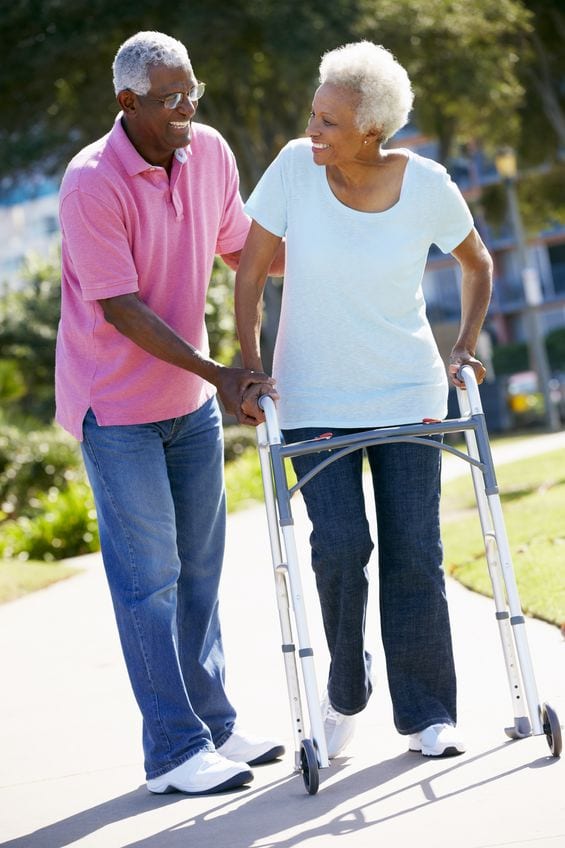Having the right equipment makes all the difference in how well you function.
Purchasing mobility equipment is like buying a suit of clothes; one size does NOT fit all. It’s important to have an experienced technician measure your family member to the equipment to fit it correctly. For example, when buying a wheelchair, it must fit the body perfectly to prevent skin breakdown and other injuries. The body, torso, leg, and arm length must be accurate. If it’s not, harm may occur to your family member’s body due to friction or undue stress.
If your family member gets a chair and it’s not right when they take it home, call the seller to adjust it. Keep calling until it’s right. The chair is part of their body when they are in it, and it must function correctly the same as their heart and lungs.
How to Determine the Size Wheelchair Needed
- Seat Width: measure person’s hips from side to side. Add two inches.
- Seat Depth: Measure from the back of the hip to the back of the knee while the person is seated. Subtract one inch.
- Full-length wheelchair arms: best for those who will use them to stand up and do pivot transfers. The full-length arm provides support to help push up to stand. However, it gets in the way if you need to roll under desks to work or come in close to objects.
- Desk-length wheelchair arms: Recommended for people who want to be comfortable working at a desk or table. The shorter arms allow them to get closer to the table’s edge.
- Arm Height: Height varies. Measure from the elbow to the chair seat while the person is holding their arm up with their elbows bent at a 90-degree angle. If your mobile can accommodate them, use height-adjustable arms.
Footrest Style
- Elevating Leg Rests: A doctor may order people who suffer from edema, swelling, or injury to elevate their legs. Having a wheelchair attachment that allows the legs to raise, lower, and lock in place meets that need.
- To determine the length of the footrest, measure the distance from the back of the knee to the foot’s heel.
- Articulating Leg Rests: (Useful for taller people) The leg rests extend longer while the elevating piece of the leg rest rises.
Back Height
- While seated in a wheelchair, measure from collarbone down to the seat.
- There are options for higher and reclining backrests if additional back support is needed.
Wheelchair Seat Height
- If the person needs to use their feet to propel themselves in the chair, measure the distance from the back of the knee to the heel of the foot. The seat height should allow the person to reach the floor with their heels.
Weight Considerations
- Wheelchairs have weight limits. Know the person’s weight and the wheelchair’s limits to know they are compatible.
- Some people fold their own chairs to travel. Consider upper body strength in determining which wheelchair is best to purchase for those with weaker upper body strength. Weaker people need lighter chairs.
Resource:
How To Determine Proper Fit In a Wheelchair by Brian Carmody, www.verywellhealth.com
Helpful Safety Video Tips
Wheelchair Safety and Adjustments
Wheelchair Mobility Over Curbs
How to go Down Stairs In a Wheelchair with the Assistance of One Person
How to go Downstairs in a Wheelchair with the assistance of Two Persons
TRANSFERRING FROM A WHEELCHAIR INTO A CAR
In each of these videos, it’s important to note that individuals receive mobility devices sized to fit their body dimensions and safety precautions come first. It’s easy to forget an immobilized person’s limitations. However, it would be best if you kept that in mind always. Stay alert to potential risks of injury. Maintain awareness at all times of what may lie in front, back, and to the sides, even above and below the individual, that may cause harm if the person cannot fend off that harm. Make it a habit to assess the environment for potential risks each time you stop and settle in a new location for an extended period.
This video explains how to use a walker to maintain balance in walking correctly. Drug stores and many general merchandise stores have walkers available for purchase. However, if you plan to get one, it needs to be the right height and easy to manage when getting in and out of a vehicle for ease of use.
This video explains the best time to use a rollator walker and what precautions to take when using one.
Canes help maintain balance. It needs to be the correct size to achieve the desired result, like a walker. If it’s too short or long, it will not be effective and may cause the user to lose balance.
How to Use a Walking Stick to Climb Steps
Step up with the unaffected leg first, place the walking stick on the step, and step up with the affected leg. Coming down: place the walking stick on the step below first, hold the rail, bring the affected leg down, then the unaffected leg down.
This video explains the proper use of crutches. Size crutches so that two fingers can fit between the top of the rest area and the shoulder rest for the animal. This cushion is needed to prevent injury to the nerves under the armpit.
This video demonstrates the use of forearm crutches.
Which Convaid Stoller is Best for My Special Needs Child?
This video provides examples of the different functions available in this stroller for special needs children. Other manufacturers also make this type of product, but this is a sample for you to consider.
How to Adjust a Platform Walker
Physical Therapists Bob Schrupp and Brad Heineck describe how to determine the height for an upright walker and adjust the platform walker level correctly.

